

New Discovery Simplifies Quantum Physics. Artist’s rendering of the amplituhedron, a newly discovered mathematical object resembling a multifaceted jewel in higher dimensions.

Encoded in its volume are the most basic features of reality that can be calculated — the probabilities of outcomes of particle interactions.Illustration by Andy Gilmore That’s right ladies and gentlemen, quantum mechanics just got easier to understand. A team of physicists have released a paper showing their discovery of a jewel-like geometric structure that takes equations, which can be thousands of terms long, and simplifies them to a single term. This discovery is poised to dramatically simplify the equations particle physicists use when calculating particle interactions. Derek Leinweber.
Yves Couder. In the first decades of the 20th century, physicists hotly debated how to make sense of the strange phenomena of quantum mechanics, such as the tendency of subatomic particles to behave like both particles and waves.
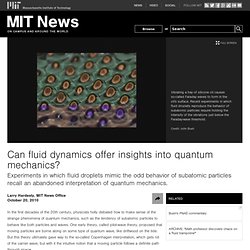
One early theory, called pilot-wave theory, proposed that moving particles are borne along on some type of quantum wave, like driftwood on the tide. Study of SubAtomic Interactions through Lattice Quantum Chromo Dynamics on Mare Nostrum (SAIL) Abstract Quantum Chromodynamics (QCD) is the underlying theory governing the interaction between quarks and gluons, the strong force, and therefore, responsible for all the states of matter in the Universe. Guhr's research. Quantum Chaos and Random Matrix Models Random matrices provide powerful models for a rich variety of complex systems. Here is a brief overview. A good example is the atomic nucleus shown to the right. It consists of many nucleons, the protons (blue) and the neutrons (red). They all interact with each other and move in a very complicated way. In several different branches of physics, we study chaotically coupled systems or, equivalently, systems with symmetry breaking.
Disordered systems are a wide field for applications of Random Matrix Models. Local collaborator: Johan Grönqvist (PhD-student) external collaborators: Professor Achim Richter and his group at Technical University of Darmstadt, Professor Hans-Jürgen Stöckmann at University of Marburg. Quantum entanglement. Quantum entanglement is a physical phenomenon that occurs when pairs or groups of particles are generated or interact in ways such that the quantum state of each particle cannot be described independently – instead, a quantum state may be given for the system as a whole.

Such phenomena were the subject of a 1935 paper by Albert Einstein, Boris Podolsky and Nathan Rosen,[1] describing what came to be known as the EPR paradox, and several papers by Erwin Schrödinger shortly thereafter.[2][3] Einstein and others considered such behavior to be impossible, as it violated the local realist view of causality (Einstein referred to it as "spooky action at a distance"),[4] and argued that the accepted formulation of quantum mechanics must therefore be incomplete. History[edit] Charm quark. The charm quark or c quark (from its symbol, c) is the third most massive of all quarks, a type of elementary particle.
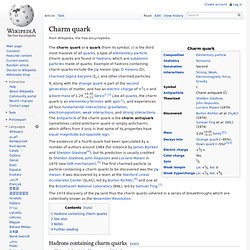
Charm quarks are found in hadrons, which are subatomic particles made of quarks. Example of hadrons containing charm quarks include the J/ψ meson (J/ψ), D mesons (D), charmed Sigma baryons (Σ c), and other charmed particles. The mystery of matter deepens - physics-math - 07 January 2013. "IF YOU haven't found something strange during the day," John Archibald Wheeler is said to have remarked, "It hasn't been much of a day.
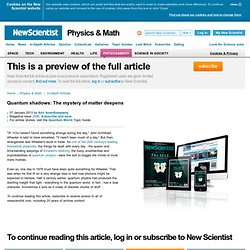
" But then, strangeness was Wheeler's stock in trade. As one of the 20th century's leading theoretical physicists, the things he dealt with every day - the space- and time-bending warpings of Einstein's relativity, the fuzzy uncertainties and improbabilities of quantum physics - were the sort to boggle the minds of most mere mortals. Even so, one day in 1978 must have been quite something for Wheeler. That was when he first lit on a very strange idea to test how photons might be expected to behave. EPR, Bell & Aspect: The Original References. EPR, Bell & Aspect: The Original References (in PDF Format) By David R.
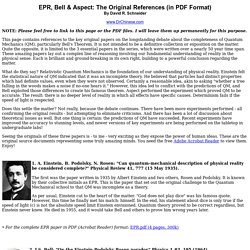
Schneider www.DrChinese.com NOTE: Please feel free to link to this page or the PDF files. I will leave them up permanently for this purpose. Quantum entanglement. Quantum resonator. Pilot wave. Schrödinger equation. In quantum mechanics, the Schrödinger equation is a partial differential equation that describes how the quantum state of some physical system changes with time.
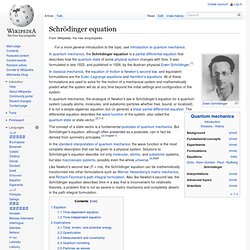
It was formulated in late 1925, and published in 1926, by the Austrian physicist Erwin Schrödinger.[1] In classical mechanics, the equation of motion is Newton's second law, and equivalent formulations are the Euler–Lagrange equations and Hamilton's equations. Wave function collapse. When the Copenhagen interpretation was first expressed, Niels Bohr postulated wave function collapse to cut the quantum world from the classical.[5] This tactical move allowed quantum theory to develop without distractions from interpretational worries.

Mathematical description[edit] Mathematical background[edit] Interpretations of quantum mechanics. An interpretation of quantum mechanics is a set of statements which attempt to explain how quantum mechanics informs our understanding of nature.
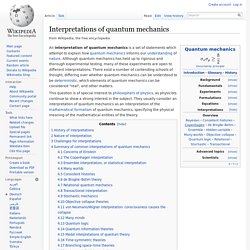
Although quantum mechanics has held up to rigorous and thorough experimental testing, many of these experiments are open to different interpretations. Antony Valentini. Antony Valentini is a theoretical physicist and a professor at Clemson University.

He is known for his work on the foundations of quantum physics.[1] Education and career[edit] Valentini obtained an undergraduate degree from Cambridge University, then earned his Ph.D. in 1992[2] with Dennis Sciama at the International School for Advanced Studies (ISAS) in Trieste, Italy.[1][3] In 1999, after seven years in Italy, he took up a post-doc grant to work at the Imperial College with Lee Smolin and Christopher Isham.[1] He currently works at the Perimeter Institute for Theoretical Physics.
Since February 2011, he is professor of physics and astronomy at Clemson University.[4] Work[edit] The Higgs Boson and Our Views of Universe Creation. Today scientists from the European Organization for Nuclear Research, or CERN, will make a groundbreaking announcement. It will be about their most recent finding; of evidence that strongly suggests the existence of the Higgs boson. 'The Higgs what? ', you ask? Really we should all know the answer.
These particles are what populate something known as the 'Higgs field'. "Some liken the effect to a ubiquitous Higgs snowfield that affects other particles traveling through it depending on whether they are wearing, metaphorically speaking, skis, snowshoes or just shoes. " As the explanation for why mass 'is,' non-scientists have deemed Higgs bosons, 'God particles.' 1. 2. 3. 4. 5. Photo credit: Shutterstock, One-Mind-One-Energy.com, ScienceBuzz.org, Crystalinks.com, Experimentation-Online.com.